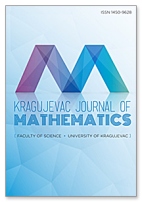Iterative Algorithm of Split Monotone Variational Inclusion Problem for New Mappings
 Download PDF
Download PDF
Authors: M. FARID, S. S. IRFAN AND I. AHMAD
DOI: 10.46793/KgJMat2105.667M
Abstract:
In this paper, first we define the notion of an Engel polygroup, to get further properties on Engel fuzzy subpolygroups. Moreover, we prove that every normal fuzzy subpolygroup of an Engel polygroup is Engel. Furthermore, we introduce the notions of solvable and nilpotent fuzzy subpolygroups and we get some of their properties. Finally we investigate the relations among solvable and nilpotent fuzzy subpolygroups with Engel fuzzy subpolygroups.
Keywords:
Engel group, Engel polygroup, (Engel, solvable, nilpotent) fuzzy subpolygroup.
References:
[1] H. Aghabozorgi, B. Davvaz and M. Jafarpour, Nilpotent groups derived from hypergroups, J. Algebra 382 (2013) 177–184.
[2] R. Ameri, R. A. Borzooei and E. Mohammadzadeh, Engel fuzzy subgroups, Ital. J. Pure Appl. Math. 34 (2015), 251–262.
[3] R. Ameri and E. Mohammadzadeh, Engel groups derived from hypergroups, European J. Combin. 44 (2015), 191–197.
[4] R. Ameri and H. Hedayati, Fuzzy isomorphism and quotient of fuzzy subpolygroups, Quasigroup Related Systems 13 (2015), 175–184.
[5] S. Bachmuth and H. Y. Mochizuki, Third Engel groups and the Macdonald-Neumann conjecture, Bull. Austral. Math. Soc. 5 (1971), 379–386.
[6] R. Biswas, Fuzzy subgroups and anti fuzzy subgroups, Fuzzy Sets and Systems 35 (1990), 121–124.
[7] R. A. Borzooei, E. Mohammadzadeh and V. Fotea, On Engel fuzzy subpolygroups, New Math. Nat. Comput. 13(2) (2017), 165–206.
[8] P. Corsini, Prolegomena of Hypergroup Theory, Aviani Editore, Tricesimo, 1993.
[9] B. Davvaz, Polygroup Theory and Related Systems, World Scientific, Basel, 2013.
[10] B. Davvaz and I. Cristea, Fuzzy Algebraic Hyperstructures. An Introduction, Springer-Verlag, Berlin, 2015.
[11] N. D. Gupta and K. W. Weston, On groups of exponent four, J. Algebra 17 (1971), 59–66.
[12] H. Heineken, Engelsche elemente der lange drei, Illinois J. Math. 5 (1961), 681–707.
[13] L. C. Kappe and W. P. Kappe, On three-Engle groups, Bull. Austral. Math. Soc. 7 (1972), 391–405.
[14] F. W. Levi, Groups in which the commutator operation satisfies certain algebraic conditions, J. Indian Math. Soc. 6 (1942), 87–97.
[15] F. Marty, Sur une generalization de la notion de groupe, 8th Congress Math. Scandenaves, Stockholm, Sweden, 1934, 45–49.
[16] E. Mohammadzadeh and R. A. Borzooei, Nilpotent fuzzy subgroups, Mathematics 6(27) (2018), DOI 10.3390/math6020027.
[17] E. Mohammadzadeh, R. A. Borzooei and Y. B. Jun, Results on Engel fuzzy subgroups, Algebraic Structures and Their Applications 4(2) (2017), 1–14.
[18] D. J. S. Robinson, Finitiness Conditions and Generalized Soluble Groups (Part 2), Springer-Verlag, New York, Berlin, 1972.
[19] D. J. S. Robinson, A Course in the Theory of Groups, Springer-Verlag, New York, 1980.
[20] A. Rosenfeld, Fuzzy groups, J. Math. Anal. Appl. 35 (1971), 512–517.
[21] M. Suzuki, Group Theory I, Springer-Verlag, Berlin, New York, 1982.
[22] L. A. Zadeh, Fuzzy sets, Information and Control 8 (1965), 338–353.
[23] M. Zahedi, M. Bolurian and A. Hasankhani, On polygroups and fuzzy subpolygroups, J. Fuzzy Math. 1 (1995), 1–15.
[24] M. Zorn, Nilpotency of finite groups, Bull. Amer. Math. Soc. 42 (1936), 485–486.
